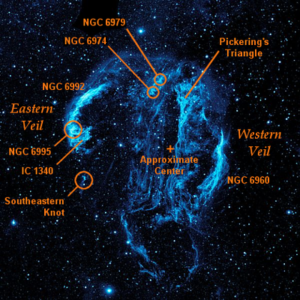“The last astro image I recently sent was NGC 6960, the Western Veil Nebula. As you may remember, it is a remnant of a supernova explosion that occurred to a nameless star in the constellation of Cygnus some 3,000 to 6,000 years ago. The shock waves of gas from the explosion formed a spherical shell moving outwards from the dying star. While most of the shock wave is invisible to us, several of it’s brighter arcs are detectable by the eye using special filters. Photographically, the shock waves of oxygen, hydrogen and sulfur are readily detectible.
I mentioned in my last email my next image would be of NGC 6992, the Eastern Veil Nebula. That image is attached, and while it is similar to NGC 6960, you can see differences in the amount of oxygen (blue) and hydrogen (red). It is believed the shock waves are relatively thin. This is what causes the appearance of filaments of gas, since they are only visible when they line up along our line of sight. The twisting of the filaments are actually undulations in the surface of the spherical shock wave that is moving outwards.
In order to provide a bit of perspective, here is a small graphic from the internet which shows the entire nebula in infrared light, with the major structures indicated. The approximate center is where the original star explosion occurred:

Now, when you examine my attached image, you can get a sense of the overall size as compared to the relatively small area I am imaging. The entire nebula is believed to be some 70 light years in diameter, at a distance of almost 1500 light years. This nebula resides in the next closest arm of our Milky Way Galaxy.
By the way, when you look at the internet photo, and the names of the nebula, you will note a rather curious thing. It is not a mistake, but can you see it?
Do you see the designations of East and West confused? Well, they are not- it’s just a matter of reference. On the surface of the Earth, East and West are defined by meridians of longitude running left or right from the prime meridian. In the sky, the reference point is is not from the surface of the Earth, but rather an imaginary vantage point infinitely far away where the observer is looking DOWN upon the Earth. Now you can see the familiar orientation of West and East being left and right, respectively!
Hope you enjoy my image of NGC 6992, the Eastern Veil.”
Bob Rieger
Leave a Reply
You must be logged in to post a comment.